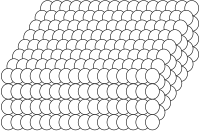
Photo from wikipedia
Integrating two-dimensional (2D) transition-metal dichalcogenides (TMDCs) into dielectric plasmonic nanostructures enables the miniaturization of on-chip nanophotonic devices. Here we report on a high-quality light emitter based on the newly designed… Click to show full abstract
Integrating two-dimensional (2D) transition-metal dichalcogenides (TMDCs) into dielectric plasmonic nanostructures enables the miniaturization of on-chip nanophotonic devices. Here we report on a high-quality light emitter based on the newly designed 2D h-BN/WS2 heterostructure integrated with an array of TiO2 nanostripes. Different from a traditional strongly coupled system such as the TMDCs/metallic plasmonic nanostructure, we first employ dielectric nanocavities and achieve a Purcell enhancement on the nanoscale at room temperature. Furthermore, we demonstrate that the light emission strength can be effectively controlled by tuning the polarization configuration. Such a polarization dependence meanwhile could be proof of the resonant energy transfer theory of dipole-dipole coupling between TMDCs and a dielectric nanostructure. This work gains experimental and simulated insights into modified spontaneous emission with dielectric nanoplasmonic platforms, presenting a promising route toward practical applications of 2D semiconducting photonic emitters on a silica-based chip.
Journal Title: Nano letters
Year Published: 2022
Link to full text (if available)
Share on Social Media: Sign Up to like & get
recommendations!